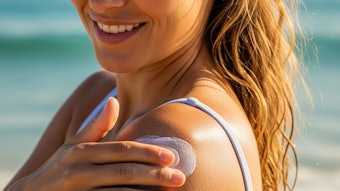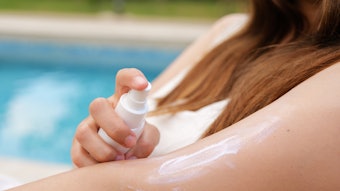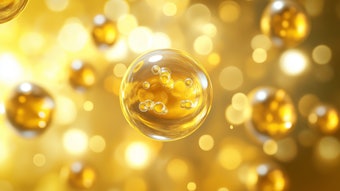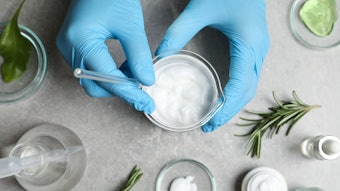Titanium (IV) dioxide (TiO2) is one of the most well-known and commercially important inorganic pigments. It is used to provide white color and opacity to paints and coatings, plastics, paper, inks, food products and pharmaceuticals. While TiO2 is often incorporated as a colorant and an opacifier in cosmetics and personal care products, its most important applications are as a sunscreen active and as a component of specialty pigments for color cosmetics. Both the INCI and established drug names for TiO2 are titanium dioxide; however, when used as a colorant in the EU, it is identified by the Colour Index (CI) number 77891.1
Chemistry and Manufacture
TiO2 is a naturally occurring mineral found in three forms: anatase, brookite and rutile, which differ by crystal structure and the number of titanium and oxygen atoms per unit cell of the crystal lattice.2 These TiO2 forms also differ by density, hardness and refractive index due to the differences in their structure. The TiO2 found in nature contains small amounts of impurities such as iron, chromium or vanadium; therefore, it must be chemically refined to obtain the high purity required for most applications, including cosmetics and personal care. TiO2 also may be derived from the naturally occurring mineral ilmenite, a crystalline iron titanium oxide (FeTiO3). In this case, the ilmenite ore must be smelted to remove the iron oxides before the remaining titaniferous slag can be converted into TiO2.
There are two different commercial processes used to produce refined TiO2, the sulfate process and the chloride process.2, 3 The older sulfate process, illustrated in Figure 1, is a batch process that entails the digestion of crude TiO2 or FeTiO3 ores with sulfuric acid to form titanyl sulfate (TiOSO4), and the separation of the metal impurities as sulfate salts, e.g. iron(II) sulfate. The TiOSO4 is then hydrolyzed to yield TiO2 hydrates as a precipitate. The precipitated TiO2 hydrates are filtered, washed and subjected to high temperature calcination (800–930°C) to form pure TiO2 crystals. The sulfate process has the flexibility to produce either the anatase or rutile forms of TiO2, depending on the exact hydrolysis and calcination conditions employed. These TiO2 crystals must then be ground and milled to achieve the proper particle sizes and size distributions required for use as pigments. The modern and continuous chloride process has eclipsed the sulfate process due to its improved operating efficiency and reduced waste output. The sulfate process generates metal sulfates, e.g. iron sulfate, as waste, and these sulfates and waste sulfuric acid are difficult to recover and recycle. In contrast, the chlorine process recycles chlorine gas (Cl2) directly back into the process. The sulfate process uses feedstocks with lower TiO2 content, so more waste must be separated. Also, continuous processes are inherently more efficient than batch processes.
In the continuous process shown in Figure 2, crude TiO2-containing minerals are reacted with Cl2 in the presence of coke (carbon) at 800–1200°C to produce titanium tetrachloride (TiCl4), a liquid compound that is then distilled to yield high purity TiCl4. The TiCl4 is reacted with oxygen or steam at 900–1400°C to form TiO2 pigment particles, known as fumed titania, and Cl2 gas, which is recycled into the process. Chloride process TiO2 is predominantly in rutile form. A key advantage of the chloride process is that the operating parameters can be adjusted to provide pigments with precisely defined particles sizes ranging from tens to hundreds of nanometers in diameter, eliminating the need for extensive grinding and milling operations.
An important post-treatment step commonly employed in the manufacture of TiO2 pigments is the surface modification of the TiO2 with thin coatings of alumina (Al2O3) or silica (SiO2) hydrates to help optimize performance attributes, such as dispersibility and dispersion stability.2 Deposition of these hydrous oxides onto the TiO2 particles is usually achieved via hydrolysis of aluminum salts or silicates in aqueous dispersions of TiO2 under alkaline or acidic conditions, respectively. In the absence of this surface treatment, TiO2 exhibits high photocatalytic activity upon exposure to ultraviolet (UV) light and can lead to the photochemical degradation of other formulation components such as organic UV filters, emollients, film-formers, fragrances, etc., through the generation of hydroxyl radicals at the particle surface.
Properties
Pure TiO2 is typically supplied as a free-flowing white powder that is nontoxic and safe for ingestion.2, 3 It is the predominant white pigment and opacifier due to its high refractive index—2.54 and 2.75 for the anatase and rutile forms, respectively—and minimal optical absorption at visible wavelengths. TiO2 is an excellent absorber of UVB light (280–315 nm) but it is generally ineffective at absorbing in the UVA range (315–400 nm); however, TiO2 with improved absorption in the UVA range has been developed by doping TiO2 crystals with manganese (Mn) ions.4, 5 Mn-doped TiO2 has also been reported to reduce the photocatalytic activity of TiO2 below that of conventional silica- or alumina-treated grades.
Technology and Applications
TiO2 is a high-volume, commodity inorganic chemical. In the United States alone, it is estimated that 1.4 million metric tons of TiO2 were produced in 2010.6 The majority of this volume is pigmentary TiO2 with particle sizes of 200–400 nm, designed for maximum light scattering and opacity. However, the performance requirements of cosmetic and personal care applications require specialized forms of TiO2 that are fabricated to provide unique features such as smaller particle sizes, hydrophobic surface treatments or composite structures with other inorganic materials.
In the United States, TiO2 is a US Food and Drug Administration (FDA)-approved sunscreen active for over-the-counter drug products, with 25% w/w being the maximum concentration permitted.7 So-called attenuation grades of TiO2 with particle sizes below 100 nm have also been developed to prevent the TiO2 from causing undesirable whiteness on the skin when applied as a sunscreen; since the particle sizes of attenuation grade TiO2 are significantly smaller than the wavelengths of light in the visible spectrum, i.e. 390 nm–750 nm, these materials do not reflect visible light and instead appear transparent on the skin. Nevertheless, while this TiO2 is quite efficient at absorbing UVB light, it must be used in conjunction with a UVA absorber, e.g. zinc oxide, for complete UV protection. Also, despite allegations of potential dermal absorption due to its nanoscopic dimensions and modified surface properties, several peer-reviewed studies have demonstrated that attenuation grade TiO2 does not pose a skin penetration hazard.8–10
For efficient UV protection, sunscreen products must deliver a uniform film of TiO2 when applied to the skin. Proper film formation and consumer-acceptable product aesthetics are achieved by ensuring a homogeneous dispersion of the TiO2 in the oil phase of sunscreen emulsions, whether it is an o/w or w/o system. Pure TiO2 and its alumina- and/or silica-treated analogs possess hydrophilic surfaces that must be rendered hydrophobic to enable compatibility and dispersibility in the oil phase. Therefore, TiO2 for sunscreen applications is frequently surface-treated with hydrophobic compounds that are either physically or covalently bound to the particle surface.11–13 Notable examples of hydrophobic surface modifiers for TiO2 include steric acid, isosteric acid, polyhydroxysteric acid, polyglyceryl-6 polyhydroxystearate, trimethoxycaprylsilane and dimethicone/methicone copolymer. To facilitate easier formulation compounding of hydrophobized TiO2 ingredients, they are also offered as preformed dispersions in commonly used emollients, such as C12–15 alkyl benzoate, caprylic/capric triglyceride, diethylhexylcarbonate and dimethicone.
Besides UV protection, as noted, TiO2 is a critical component in specialty effect pigments such as interference pigments.14–15 Although a complete discussion of these pigments is beyond the scope of the present column, in brief, the high refractive index of TiO2 enables pigment manufacturers to achieve distinct colors and unique optical effects, e.g. pearlescence and color travel, by depositing nanometer-scale layers of TiO2 on the surfaces of mica platelets—for instance, to form TiO2-on-mica pigments (INCI: Titanium dioxide (and) Mica). Such surface deposition may be achieved by controlled hydrolysis of TiOSO4 or TiCl4 in an aqueous suspension or fluidized bed of muscovite mica followed by filtration, drying and calcination. The utility of TiO2 in manufacturing pigments for cosmetics is quite evident, based on the hundreds of TiO2-based colorants listed as trade name mixtures in the Personal Care Product Council’s On-Line INFOBASE.16
References
1. Titanium Dioxide, Monograph ID 3217, in the International Cosmetic Ingredient Dictionary and Handbook, 13th Ed., Personal Care Products Council: Washington DC (2010)
2. J Fisher and TA Egerton, Titanium Compounds, Inorganic, in Kirk-Othmer Encyclopedia of Chemical Technology, Published online: John Wiley & Sons (Jul 13, 2001) pp 1–58
3. PM Kuznesof and MV Rao, Chemical and Technical Assessment (CTA) of Titanium Dioxide, 67th Meeting of the Joint FAO/WHO Expert Committee on Food Additives, published online at ftp://ftp.fao.org/ag/agn/jecfa/cta_tio2.pdf (2006)
4. WO2008117017A1, Particulate titanium dioxide, IR Tooley, assigned to Croda International PLC (Oct 2, 2008)
5. Optisol and Optisol TD-50, Croda Product Bulletin DS-202R-5, Croda Inc., Edison, NJ, USA (Jul 20, 2009)
6. J Gambogi, Titanium and titanium dioxide, Mineral Commodity Summaries, U.S. Geological Survey, published online at https://www.usgs.gov/centers/national-minerals-information-center/titanium-statistics-and-information (Jan 2011)
7. Code of Federal Regulations, 21 CFR 352, Sunscreen drug products for over-the-counter human use [stayed indefinitely] (Apr 1, 2010)
8. F Pflücker et al, The human stratum corneum layer: An effective barrier against dermal uptake of different forms of topically applied micronised titanium dioxide, Skin Pharmacol Appl Skin Physiol 14(suppl 1) 92–97 (2001)
9. AO Gamer, E Leibold and B van Ravenzwaay, The in vitro absorption of microfine zinc oxide and titanium dioxide through porcine skin, Toxicol In Vitro 20 3 301–307 (Apr 2006)
10. N Sadrieh et al, Lack of significant dermal penetration of titanium dioxide from sunscreen formulations containing nano- and submicron-size TiO2 particles, Toxicol Sci 115 1 156–166 (May 2010)
11. LK Kessell, BJ Naden, IR Tooley and TF Tadros, Application of colloid and interface science principles for optimization of sunscreen dispersions, Coll Interface Sci Ser 4 61–78 (2008)
12. US20090098206A1, Particulate metal oxide, LM Kessell and IR Tooley, assigned to Croda International PLC (Apr 16 2009)
13. Univul, T-Lite and Z-COTE Grades, BASF Technical Bulletin MEMC 050103e-02, BASF AG, Ludwigshafen, Germany (Jun 2006)
14. N Horiishi et al, Specialty Pigments, Chapter 5 in Industrial Inorganic Pigments, Third Edn, G Buxbaum and G Pfaff, eds. Wiley-VCH Verlag GmbH & Co. KGaA: Weinheim, Germany (2005) pp 195–295
15. P Linz and Q Peng, Color-travel cosmetic pigments: Interference to the max, Cosm & Toil 118 12 63–66, 68, 70 (2003)
16. Titanium Dioxide, trade name mixtures, Personal Care Products Council On-Line INFOBASE, https://online.personalcarecouncil.org/jsp/IngredientDetail.jsp?monoid=3217 (Accessed Apr 5, 2011)










